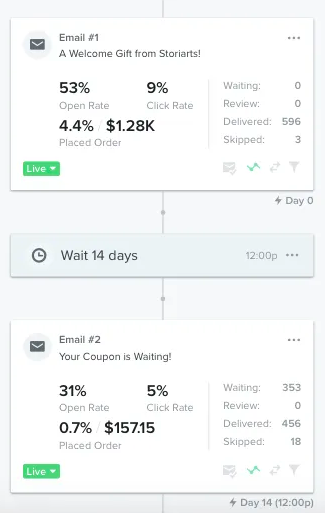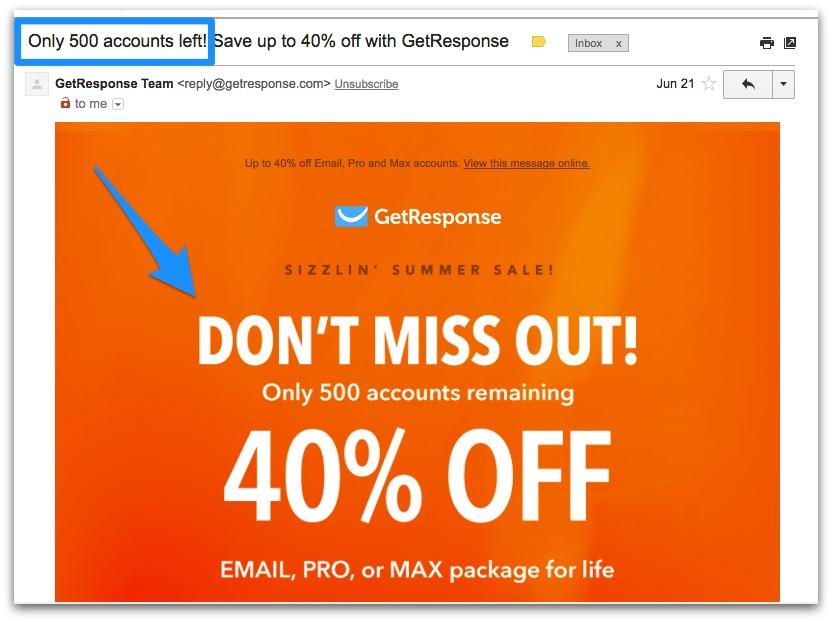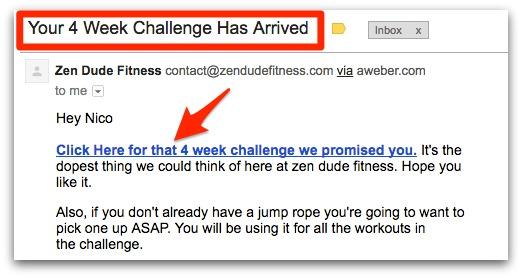By sending two simple cart abandonment emails to 596 subscribers, Storiarts made an extra $1,437.
The first email alone has a $24 EPC (earnings per click).

Before you shoot out a quick email and race off to the nearest Jag dealership, know this: Most emails never get opened.
But there’s one thing you control that determines whether or not your email grabs hold of your subscriber’s eyes and gets them to open it.
Your email subject line.
That’s why in this guide, I will show you everything you need to know to create kick-ass subject lines that’ll skyrocket your open rates and Sumo-size your income.
Together, we’re going to pick apart the psychology behind 13 proven subject line examples, so you can learn the concepts and strategies, and inject them into your own emails right away.
%(tableofcontents)
When these subject lines work, you better have amazing emails to close the loop. For inspiration, get our FREE email templates based on killer emails sent by Ramit Sethi, REI, and more.
Click Here to Get the Templates
Let’s get started:
Subject Line Example #1: The Bold & Audacious Subject Line
$10,000 on my first webinar? Yes please.
If you want to stand out among a sea of newsletters with “limited-time-discounts” and mundane subject lines that clutter the inbox every morning, you need to strike a cord and get your audience to feel. Perk them up with an audacious subject line that practically forces them to click “open” and see what’s inside.
Emotion drives action, and the survival of your business depends on people taking action. Studies show that evoking a “high-arousal” emotion is the “secret sauce” that makes content go viral.[*]
When I saw this eye-catching email from Amy Porterfield, the dollar sign and zeros immediately stood out among the flood of other numbers, caps, and symbols, and became an “instant-open”:

But there’s more to this subject line than a flashy (and borderline outrageous) financial promise.
What am I talking about?
Hope.
It can get us through tragic, painful, and enormously uncomfortable situations, but smart marketers know that hope can also drive us to take massive action.
Amy understands two things:
- Newer members of her tribe might be skeptical about how profitable their first webinar could be.
- If you don’t believe there’s even a fighting chance of success with your first webinar, you’ll never take action in the first place.
But if she can prove to you that it's possible to have a profitable first webinar (instead of you crashing down in flames in front of a live audience) she might be able to tip the scale just enough for you to give it a shot.
And in this case, “give it a shot” means buy her online course.
How to Use It
Depending on which stage of the customer lifecycle your prospect is at, a decent chunk of your audience is sitting there completely stumped, stuck wondering if their goal is even attainable in the first place.
To put this subject line to work for you, dig deep into your audience's hopes and dreams, and show them how everything they lust after is on the other side of your strategically optimized checkout page.
Pro tip: if someone hasn’t bought your product, it’s because they don’t think it can get them the results they want. If they knew it was possible for them, they’d have taken action already. 🙂
Subject Line Example #2: The “FOMO” Subject Line
Only 500 accounts left! Save up to 40% off with GetResponse
Ever scrolled through your Instagram feed while you were at lunch with a friend?
Or watched your BBF’s Snapchat Story and wished you were chilling with them instead?
Yeah. #FOMO.
Also known as the fear of missing out, FOMO is that nagging anxiety that something more fun, more engaging, or otherwise better than what you’re doing right now is happening somewhere else…and you’re missing it.
One of the oldest marketing tricks in the book, we’ve all experienced the fear of missing out from time to time, whether it was in our personal lives, or in an email subject line:

GetResponse knows this, so making it painfully obvious that their audience is missing out on a whopping 40% off is a killer strategy to hit their prospects with a pang of anxiety and prod them into opening up that email and taking action.
How to Use It
Tapping into the fear of missing out is easy when you know your audience.
Just pick one of their goals, hopes, or dreams, and dangle it in front of them. Explicitly show them what they’re missing out on, and how they can get it now, by taking the action you want. Just make sure you’re being honest!
Subject Line Example #3: The Introspective Subject Line
Where do you want to be 3 months from now? (bonuses expire TONIGHT)
Being asked about your hopes, goals, and dreams can get emotional…
Especially when you don’t have a clear-cut answer.

Asking a question that forces someone to:
- Use their imagination.
- Visualize themselves in the future.
- See a different version of themselves or their business.
This is an extremely effective strategy for getting people to make a powerful mental shift and take action (and not just in business).
World-class athletes and Olympic gold medalists swear by visualization as a preparation technique to maximize their odds of hitting their goals with laser-like precision.[*]
Melyssa Griffin uses this strategy by asking her audience where they picture themselves in 3 months:

Once you open the email, Melyssa spells out a plan to help get you there using Pinterest.
How to Use It
If you have a product or service to sell, you can easily steal the idea behind this headline and make it work to your advantage.
Everyone loves to daydream about how their life could be better, how the grass could be greener, or how they can improve their business and increase their income.
Inside the email, get your audience to actually create concrete, measurable goals, pick a specific date and commit. Then show them how you can help get them where they want to go with the help of your product or service.
Subject Line Example #4: The Controversial Subject Line
Some Practical Thoughts on Suicide
Anything too controversial or touchy can get ugly… fast. So why is this type of email subject line so powerful?
When executed strategically, a controversial subject line can be unique, intriguing, and unexpected.
Most entrepreneurs wouldn’t even consider sending out an email about anything too taboo, at the risk of ruffling too many feathers. But Tim Ferriss has never been one to play it safe:

This example is grim, but if you’re a member of Tim Ferriss’s audience, you know his books, articles, and videos are, well… unique.
Since Tim has a track record of exploring possibly the weirdest and most fascinating corners of the human mind, this is an “instant-open” for his army of dedicated followers.
How to Use It
Fill in “Some practical thoughts on X” with:
- Something a bit controversial.
- A negative idea or outcome in your niche.
- One of your audience’s major pain points.
This gets your subscribers curious where you’re headed with the subject line.
But while curiosity and controversy can be a good thing in marketing, make sure it’s the right kind of controversy. Pick something that’ll spark a lively debate on an interesting topic, rather that something that’s negative, hurtful, or too racy.
Subject Line Example #5: The “If-Then” Subject Line
If you have a website, you need this tool
Because of how our brains are wired, “if-then” statements are extremely effective triggers for behavior change and habit formation. And it just so happens that all 5 ways to trigger new behaviors, habits, and thought patterns rely on this simple “if-then” paradigm.[*]
Sumo capitalizes on this behavioral psychology trigger in what feels like a pretty harmless email subject line:

Surprise: most Sumo users have websites.
And most websites need tools… which means most Sumo users will pop this email open the second it lands in their inbox.
This is a super simple concept to apply to your own email subject lines.
How to Use It
Easy to implement, the key with an effective “if-then” statement is to make sure the “if” part is true for your audience (or at least for a large segment of them).
Here’s what I mean: “If you have a website” needs to describe most (or all) of your target audience. For Sumo, it does.
Choose a common descriptor or a bucket that most of your audience falls into, pick the action you want them to take, and slap ‘em together. Simple, yet powerful.
Subject Line Example #6: The “Remember That One Time…” Subject Line
Semi-Rad: A Backcountry Guide to Toilet Paper
This subject line example is extremely powerful. But probably not for the reason you think.
A “Remember That One Time…” subject line forces you to recall a specific memory and paint a mental image of the scenery, emotions, and senses associated with that memory.
Because of how our brains are wired, simply thinking of one tiny aspect of a memory– like the scent of the pine trees, for example– releases the floodgates to a slew of other aspects of the accompanying trip, like the chirping of the crickets by the pond, the people you were camping with, and the breathtaking greenery.
This subject line and accompanying blog post instantly trigger an onslaught of (mostly) positive memories about that entire hike, backpacking trip, or middle-of-nowhere excursion:

More specifically, it forces REI (an ecommerce store selling outdoor clothing, gear, and footwear) subscribers to recall a particularly unpleasant experience that 99% of them have had at least once before (and definitely don’t want to relive).
And when that one aspect of the memory of their trip is triggered, they’ll remember all the rest of the fun parts of the trip. When an REI subscriber remembers how unbelievably epic their last outdoors trip was… they’ll want to go on another one.
Which means they’re all primed and ready to go on an REI run. Cha-ching!
How to Use It
Whether it’s an uncomfortable experience or a delightful one, triggering a memory your target audience has already experienced will release the hounds and “flip on” their emotional switches like gangbusters.
Take a look at your customer avatar and choose a memory that a large segment (or all of) your audience share, and tug on those heartstrings like it’s your job– because as a marketer, it is. 🙂
Subject Line Example #7: The “Note From A Friend” Subject Line
can I call you tomorrow?
This subject line might not be appropriate for you. Because its effectiveness largely depends on who it’s coming from.
But notice how the casual tone and lowercase first letter make this subject line stick out and feel like it’s a personal email from a friend:

To understand why this works, think about your own email behaviors. When you open your inbox, what do you do? Chances are, you first scan to read all the subject lines. Then, you probably archive or delete the emails you see as “spam” or promotional.
Then, you likely narrow in on the personal emails. And when you get a personal email from a friend, or you feel like the email was written just for you, you’re going to open it.

In the example above, you’d likely trip out over:
- Why does he want to call me in the first place?
- What’s so top-secret he couldn’t just write it all out in an email?
With all of these aspects at play, you’re going to be so curious you can’t help but open it up and see what’s inside.
How to Use It
It’s stupid-simple to apply, but this subject line is definitely not for everyone.
If you’re an entrepreneur or one-man (or one-woman) business, and you enjoy engaging with the members of your tribe one-on-one, this is a killer strategy to boost engagement and get them to reply directly to you.
But, if you’re a larger company or brand, subject lines like this might not fly…. and they might actually feel like spam (if Netflix emailed me with this subject line, I’d be way too sketched out to open it).
Subject Line Example #8: The “Only Open If” Subject Line
Only open if you're willing to question your beliefs
Even if you’re not willing to do whatever the “only open if…” subject line suggests, the mere act of opening this email after reading the subject line subconsciously proves to yourself that you’re willing to at least consider it.[*]
This is because our actions can shape our beliefs, so acting on whatever this subject line suggests puts you in a psychologically “susceptible” state where it’s possible for your beliefs to be altered depending on what happens in the body of the email.
A bit odd at first glance, this subject line was carefully crafted by psychology and entrepreneurship guru Ramit Sethi:

Strange? Yes.
But Ramit knows exactly what he’s doing with it.
If you’re in a susceptible mentality and you read one of his (crazy-good) emails, you might not make a radical shift in an instant… but by the end his carefully crafted story contained in the body of the email, you’re probably willing to at least question your own beliefs.
How to Use It
This is a great strategy whenever you need to do some clever persuading or “soft-selling”, like in a sales email!
Simply tack on the action you want your audience to take to the end of the subject line to easily craft your own.
Here are some examples you can tweak and make your own, depending on your niche and target audience:
- “Only open if you’re finally ready to lose weight”
- “Only open if you want to adopt a puppy”
- “Only open if you’re willing to take action TODAY”
Subject Line Example #9: The Social Identity Subject Line
The Broke Girl's Guide to Healthy Eating
Smart marketers know that who we believe we are determines our actions.
In an action-driven environment like online and cross-channel marketing, subject lines that tap into your audience’s social identity are especially powerful in driving primal urges and getting us to act in accordance with who we believe we are at our core.[*]
Refinery29 knows its audience well, and uses this as an opportunity to show them healthy eating can be done…even if you’re on a tight budget:

If you identify as “broke” and the subject line screams: “Hey you, this email is only for broke people” it latches right onto that aspect of your personal identity, spiking up the odds that you’ll open up and see what’s inside.
How to Use It
You can capitalize on this powerful concept by asking:
- How does your audience describe themselves?
- What do they self-identify as?
- What descriptors do they use about themselves?
And if you’re not sure, just ask them. Here are some examples of using this psychology tool to your advantage:
- “The lazy person’s cookbook”
- “The marketer’s guide to pricing”
- “Yoga for athletes”
Subject Line Example #10: The “Here’s Your Thing” Subject Line
Your 4 Week Challenge Has Arrived
Subtle?
Yes.
Powerful?
Also yes.
Something as simple as the phrase “has arrived” can transform something intangible (like a digital product or email course) into feeling like there’s something tangible and real that’s sitting there waiting for you when you open up that email:

It also reminds you that the email is something you’ve been waiting for — and you’d never leave something you’ve been anticipating on the table.
This 4-week challenge by Zen Dude Fitness is 100% digital — it’s a collection of information, ideas, and resources, all bundled into a digital product that you can’t physically touch.
But choosing the wording “has arrived” helps to solidify the offer and makes this butt-busting 4-week challenge feel a bit more “real”.
How to Use It
Getting this trick to work for you is easy-peasy, and particularly valuable when you’re sending a digital product, a collection of ideas, or anything else that’s intangible.
Just tack on “has arrived”, “is waiting inside”, or a similar phrase to make your offer feel like a living, breathing thing.
Subject Line Example #11: The Cliff-Hanger Subject Line
Welcome to the crew, [first name]! Join us inside the…
Somehow the “Cliff-Hanger” subject line always manages to feel… unfinished.
Because it is.
In case you didn’t ace English when you were a kid, those three periods at the end of this subject line are called an “ellipse”.
You’ve probably seen ‘em everywhere, but chances are you’ve run into a misused one here and there as well.
So what’s the right way to use an ellipse? According to the punctuation guide, it’s simple: “an ellipse implies omission.”[*]
Which means some thought, idea, or sentence is left incomplete or unfinished.
In our case, it’s a subject line, and those three dots at the end build the suspense and make it clear that something’s left unfinished:

This is the first email you’ll get (from me!) if you decide to join my list, but you’ll probably feel stuck wondering:
“Join us inside the what??”
Called the Zeigarnik Effect, humans have paralyzing anxiety of leaving things unfinished. You’ve seen this time and time again in different forms but probably didn’t know what it was called.[*]
Like on this List Builder popup when you snag my 5-Figure Email opt-in offer:

And this “50% complete” bar to get access to Sarah’s video class:

These all play to the same psychological tendency towards completing something that’s unfinished.
Whether it’s this email subject line, a double opt-in, or a bowl of ice cream, finishing things is human nature.
Whether or not you actually want to.
How to Use It
You know how to use an ellipse. Just remove the final word or idea from your sentence, and add in three periods.
Subject Line Example #12: The “Belief Challenger” Subject Line
[first name], you can work full-time and build a business…
Turns out, when our core beliefs are challenged (or we’re told they’re flat out wrong) it triggers the “fight or flight” mechanism in our brains, kicking us into high gear and getting us ready to act… which in this case means opening up the email and seeing what’s inside.
While we’re on the subject of ellipses, Sarah does a killer job on her personal blog of tapping into the depths of the human brain with this seemingly benign subject line:

If you’re a member of Sarah’s audience, you know that a big chunk of “Unsettlers” still feel trapped in their “9-to-5” day jobs, only daydreaming of building their first lifestyle business.
Many of them started out still cling to the belief that “you can’t start a business while you’re working full-time.” This is what holds them back from taking action.
Sarah tackles this objection head-on in this email subject line, then proceeds to show you how it’s possible in the body of her email.
How to Use It
Don’t be afraid to hit your audience right where it hurts.
If you know enough about your customer avatar’s fears and objections, you can simply steal their exact words, flip ’em around, and challenge your tribe’s core beliefs head-on to trigger a “fight or flight” bias towards action.
Subject Line Example #13: The “You Can Do Better” Subject Line
#drivingselfies Are The Newest, Dumbest Thing Instagram Needs To Ban
Want to hear something hilarious?
70% of high-schoolers think they’re above average leaders.
And a whopping 94% of college professors believe they possess “above average teaching skills”, according to themselves.[*]
Yeah.
Called the Superiority Illusion, we humans tend to think we’re above average at most things, even though it’s only possible for 50% of us to occupy the upper half.[*]
This subject line sent by Thrillist.com taps into our fear of mediocrity (or even worse — being BELOW average) by telling us our Instagram strategy might be sub-par:
“Do NOT Commit These Instagram Atrocities”

Good thing we’ve got your back with this kickass Instagram guide to make sure your Instagram strategy doesn’t stoop that low. 🙂
How to Use It
What does your audience think they’re good at, or what do they want to be good at?
What skills and actions are necessities if they want to reach their goals?
Once you know those, use them to craft a subject line that commands they might be doing it wrong, or implies that they’re mediocre or fitting in with the “status quo”, and voila! You’ve hit the nail on the head with this easy-to-use subject line.
Now that you’ve seen 13 kickass examples of psychologically-charged subject lines:
Stop Letting 80% of Your Subscribers Ignore Your Emails
You know the crazy-good ROI a carefully crafted email campaign can deliver (just a refresher: it’s 3800%!) and you know the average open rates are depressingly low (16-23%) for all that effort you pour into your weekly newsletters and launch campaigns alike.
But no more excuses!
These 13 types of psychologically proven email subject lines can help you powerfully grab hold of your audience, get them dangerously curious, and make your email subject lines completely irresistible.
REMEMBER: Not every single one of these 13 subject lines will jive with your business, brand, or voice. But with the resources in this guide, you can implement a handful of useful and actionable subject line examples and watch your next campaign blow up.
When these subject lines work, you better have amazing emails to close the loop. For inspiration, get our FREE email templates based on killer emails sent by Ramit Sethi, REI, and more.
Add A Comment
VIEW THE COMMENTS